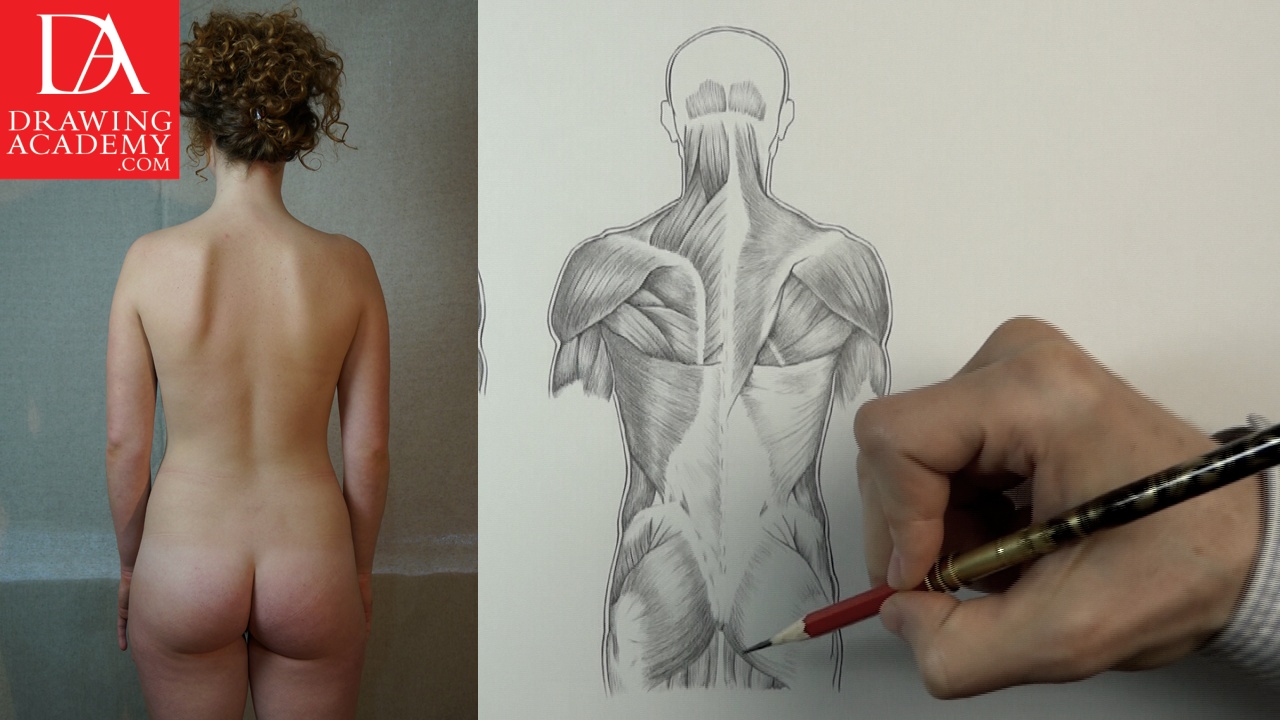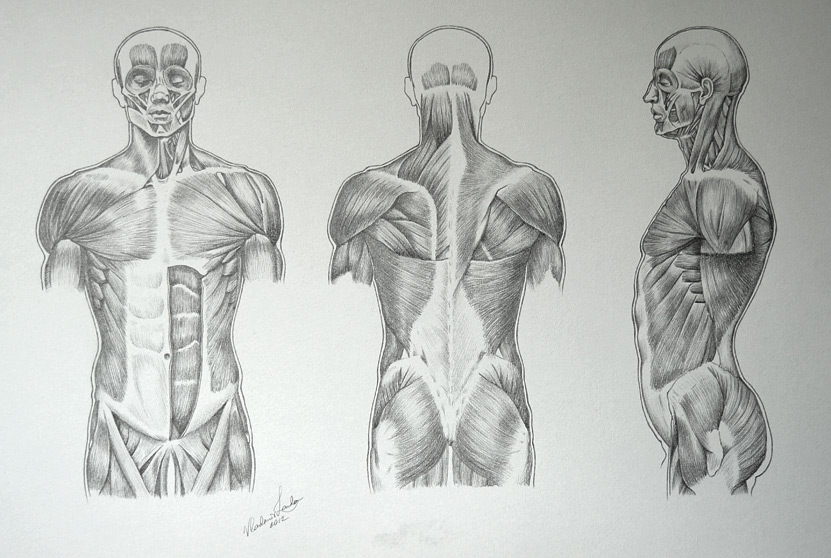Discover the Muscles in Human Body
In this video lesson you will discover the Muscles in Human Body and torso muscles in particular.
Enroll in the Drawing Academy Course
Pay once - Enjoy forever!
Only $297
Muscles in Human Body – Muscles of the Torso

Great results in drawing of a model’s body can be achieved only with the understanding of the Muscles in Human Body. Equipped with the knowledge of muscles, a fine artist can draw more realistic figurative pictures.
The awareness of Muscles in Human Body will also allow an artist to draw a body in various poses and from different points of view from memory.
The main Torso Muscles in Human Body viewed from the front (anterior view) are as follows:
– Pectoralis major
– Deltoid
– Latissimus dorsi
– Serratus anterior
– External oblique
– Rectus abdominis
– Piramidalis
Now, let’s examine those muscles in human body in more details.
The pectoralis major has three portions:
– Clavicular portion
– Sternal portion
– Abdominal portion
The portions names reflect their origin. The clavicular portion originates from the medial side of the clavicle or collar bone, the sternal portion takes its origin from the sternum or breast bone, and the abdominal portion starts from the abdominal sheath.
All three portions insert into the humerus, the bone of the upper arm.

The pectoralis major is very strong and plays a crucial role in the movement of the arm. Different portions of this muscle contribute to different movements of the arm. The clavicular portion, for example, helps in raising arms in front of the torso, this movement is called flexion.
The sternal portion is responsible in bringing arms down from a raised position, such movement is called adduction.
Working together, the clavicular and sternal portions of the pectoralis major help to rotate the arm medially.
The rectus abdominis begins from the pubic bone of the pelvis and inserts into the costal cartilages of the fifth, sixth, and seventh ribs and the xiphoid process of the sternum or breast bone. It is a powerful muscle responsible for flexion of the vertebral column and bending the torso forward.
Three horizontal fibrous lines, called transverse intersections, together with the vertical linea alba line,the form so called the “six-pack”, clearly noticeable in models with an athletic build.
Here is the posterior view of the torso.
The main muscles in human body seen from this view are as follows:
– Trapezius
– Deltoid
– Infraspinatus
– Teres minor
– Teres Major
– Triceps brachii
– Latissimus dorsi
– Aponeurosis of latissimus dorsi
– Obliquus externus
– Gluteus medius
– Gluteus maximus
These muscles in human body are closest to the surface; however, there are many more muscles of the torso that are located in deeper layers. If the trapezius muscle were to be removed, as on the left side of this image, underneath we will see the following muscles:
– Splenius capitis
– Sternocleidomastoideus
– Levator scapulae
– Rhomboideus minor
– Rhomboideus major
– Surpaspinatus
– Infraspinatus
Now, let’s examine the purpose and action of the major torso muscles in human body.
The deltoid muscle has a triangular shape and covers the shoulder from the anterior, lateral and posterior sides. Its name comes from the Greek character, Delta, which has a triangular shape.
This muscle has three portions:
– Clavicular or anterior portion
– Acromial or lateral portion
– Spinal or posterior portion
Together with other muscles, the deltoid is used in lifting and swinging the arm.
The trapezius muscle covers the back of the neck, shoulders and the upper back. This muscle has upper, middle (or transverse), and lower portions. Fibres of the upper portion go downward into the oblique direction; the middle portion’s fibres are located horizontally; and fibres of the lower portion rise obliquely.
The trapezius muscle moves the scapula bones and takes part in the elevation of the shoulders, and the extension of the neck.
The latissimus dorsi covers a large part of the back. The “V” shape of the muscle is well-pronounced on athletic figures. This muscle moves arms in different positions. It adducts and extends the arm, and also takes part in the medial rotation of the arm.
The rhomboid major and rhomboid minor muscles are located under the trapezius and help move the scapula bones.
The scapula group of muscles, indicated here, moves the arm into different positions. Each of these muscles contributes to various actions and movements of the arm, such as abduction, adduction, lateral rotation, extension and medial rotation.
The external oblique muscle covers the lateral and anterior sides of the abdomen. It begins from the outer surfaces of the lower 8 ribs, from the 5th to 12th pairs, and therefore has 8 fleshy digitations, which are noticeable on the surface of the torso, especially on athletic bodies.
Lateral flexion of the torso – to the left or to the right and the tilt of the pelvis – will result in stretching and compressing of the external oblique muscles on either sides of the body. If the torso is flexed to the right, the left external oblique muscle will be stretched, while the right one compressed. This needs to be observed and accurately depicted when drawing a model from life or imagination.
The external oblique muscles are used in many movements. Together with the rectus abdominis, the external oblique muscles take part in the flexion of the vertebral column, when the body is bent forward. The external oblique muscles also assist in lateral flexion, when the torso is bent sideways to the left or right. In addition, these muscles participate in the rotation of the torso.
The serratus anterior muscle has fleshy digitations, which begin from the first eight or nine upper ribs and insert into the vertebral border of the scapula underneath it. The bigger part of this muscle is hidden by the scapula and the latissimus dorsi muscle. On the surface of the torso, only three or four digitations of the serratus anterior muscle can be noticed. Although they might look like ribs, these protrusions are actually muscles and need to be observed and depicted carefully when drawing this part of the torso from life or the imagination.
The serratus anterior muscle is responsible for moving the scapula. The contraction of this muscle causes the scapula to move away from the vertebral column, which is the abduction or protraction of the scapula. The contraction of only the lower part of the serratus anterior muscle causes an upward rotation of the scapula.
In the Drawing Academy, you will see several video lessons where the knowledge of muscles in human body and the anatomical structure of the human torso becomes very useful. Such drawings include the well-known antique sculpture, called the Belvedere Torso, which is displayed in the Vatican Museum, Rome, and life drawings of a female model, which are also presented in the Academy curriculum as multi-part video lessons.
Artistic aesthetics of a torso, as the part of the human body without the head and limbs, developed in Greek and Roman antiquity. Many sculptors did marvellous sculptures, glorifying a well-proportioned human body. Since that time, the torso drawing has become a part of the formal artist’s education.
It is highly advisable for a fine artist to learn the muscles in human body and the torso muscles together with the human body proportions in order to depict realistic images of a human figure.




